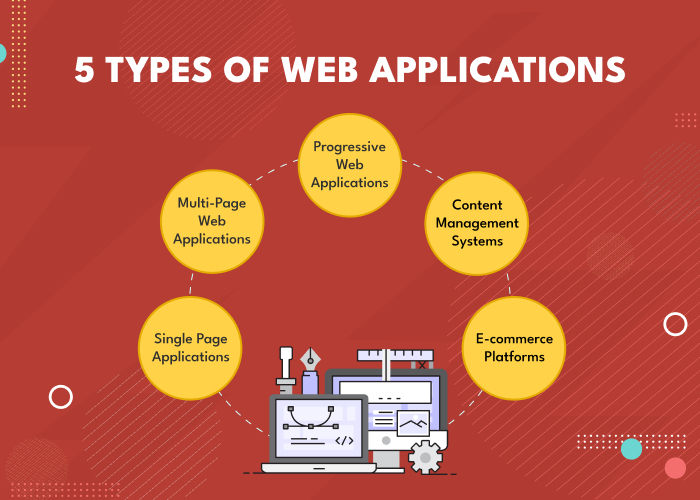Overview of Web applications
Web browsers are used by users to access web apps, which are software programs that operate on web servers. They now play a crucial role in our digital lives by providing a multitude of features and services in many different areas.
One of the key advantages of web applications is their accessibility. Users can access them from any device with a web browser and an internet connection, without the need for installation or downloads.
Web applications provide interactive experiences to users, allowing them to input data, submit forms, perform searches, view dynamic content, and interact with various elements on the page.
5 Types of Web Applications

Single Page Applications
When users engage with the application, SPAs dynamically update content on just one HTML page. These kinds of web apps are perfect for systems where performance and user experience are important. Nevertheless, because the full program must load at once, they also present certain difficulties, especially with regard to SEO optimization and initial load times. JavaScript frameworks like Angular, React, or Vue.js are used in the construction of these types of web applications because they manage the dynamic loading of user interface components and content.
Multi-Page Web Applications
Multi-page web apps (MPAs) are an architecture style of web applications in which the server serves each unique page of the application independently. MPAs switch between numerous HTML pages for various functionality, unlike single-page applications (SPAs), where the complete program is loaded into the browser and just the content changes dynamically.
Creating MPAs usually requires a more involved back-end procedure to handle several pages and their communication with the server. You may collaborate with an experienced website development business when thinking about creating these kinds of web applications to guarantee a smooth and productive online presence.
Progressive Web Applications
The greatest aspects of online and mobile application development are combined in Progressive Web Applications (PWAs). They are made to make use of the web’s reach and accessibility while providing users with an experience akin to that of a native app.
They don’t need to be downloaded from an app store; they may be installed straight from the home screen of a device. Because of this, these types of web applications are quite effective, particularly for users who don’t have much internet access. They are created by developers using common web technologies like HTML, CSS, and JavaScript.
Content Management Systems
Content Management Systems (CMS) enable individuals to produce, organize, and spread digital information online without needing a high level of technical knowledge.
In addition to capabilities like user administration, SEO optimization, and version control, they provide user-friendly interfaces for organizing, creating, and updating content.
WordPress, Joomla, Drupal, and Squarespace are a few well-known content management systems that provide a variety of configurable themes and plugins to meet different website requirements.
E-commerce Platforms
E-commerce systems enable customers to explore items, make purchases, and maintain their accounts while facilitating online transactions between buyers and sellers. To expedite the purchasing process, these platforms incorporate features like shopping carts, secure payment gateways, order management systems, and product catalogs.
A few examples are BigCommerce, Magento, WooCommerce (a WordPress-based e-commerce platform), and Shopify, which serve companies of all sizes looking to launch and grow their online sales channels.
Conclusion
In conclusion, web applications have revolutionized the way we interact with information, services, and each other on the internet. From simple static websites to complex, interactive platforms, web applications encompass a diverse array of functionalities and purposes. Whether it’s facilitating online transactions, managing content, connecting users across the globe, or streamlining productivity, web applications play a pivotal role in our digital lives.
FAQs
What is the difference between a web application and a website?
A website typically consists of static web pages with fixed content, while a web application offers interactive features and functionality, allowing users to perform tasks, input data, and interact with dynamic content.
How do I access a web application?
You can access a web application using a web browser on any device with an internet connection. Simply enter the URL of the web application in the address bar of your browser to launch it.
Are web applications secure?
Security is a critical consideration for web applications. Developers implement various security measures such as HTTPS encryption, input validation, authentication, and authorization to protect against cyber threats and safeguard user data.
What are some examples of popular web applications?
Examples of popular web applications include social networking platforms like Facebook and Twitter, e-commerce websites like Amazon and eBay, productivity tools like Google Workspace and Microsoft Office 365, and content management systems like WordPress and Drupal.
What technologies are used to build web applications?
Web applications are built using a combination of frontend and backend technologies. Frontend technologies include HTML, CSS, and JavaScript, while backend technologies may include server-side programming languages like Python, PHP, or Node.js, along with databases like MySQL or MongoDB.
Shivangi is a passionate Copywriter at Alian Software with expertise in technical copywriting. She shares information that is easy to understand regarding business, technology, and trends.